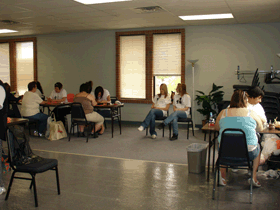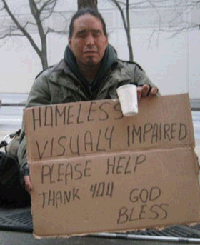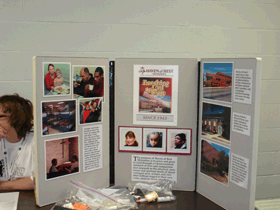The scene: homeless individuals lining up at 6:30 a.m. outside of the Chapel to get haircuts, dental care, a meal, shower, clothing and an abundance of community resources. This “answered prayer” which one woman referred to it as, was possible because of the Continuum of Care (CoC). This past April, the CoC brought together 50 different agencies under one roof to meet the needs of the homeless.
So far we’ve just barely scratched the surface of what the CoC does. It is a multifaceted venture that requires a lot of effort from many people and resources in the community to pull together.
As of right now the CoC has seven committees including: The Steering Committee, Community Meeting, Point-in-Time, SuperNOFA, Project Homeless Connect, Policy Committee and HMIS Advisory Committee. These committees gather often to discuss trends and needs in the community, as well as to formulate plans to combat homelessness and the variety of reasons it exists.
“We’re always watching trends in our community. It’s a pretty savvy group,” Sue Pierson, Chair of the CoC and Director of InfoLine said.

Committee Descriptions
The Steering Committee meets bi-monthly to provide strategic direction and leadership to the CoC process. It includes stakeholders that assign goals and tasks to other committees, monitor progress, and the overall goal achievements. They meet the second Wednesday of every month at 1:30 p.m. in the ACCESS, Inc. conference room on 230 W. Market Street.
The Community Meeting consists of community stakeholders including homeless shelters, housing, service providers, foundations, and businesses. Members share information related to the homeless population and receive updates on the progress of the CoC’s strategic plan. They meet quarterly to review and discuss various homeless issues, policies, and other homeless related trends.
Point-in-Time is an ad hoc committee that coordinates activities related to the annual count of the homeless population, which is a funding requirement of HUD (Housing and Urban Development). The committee coordinates shelter, street and other potential contacts including police, hospitals and food pantries. They go out in January of each year and count every homeless person they find throughout Akron. Student volunteers from the University of Akron often get involved. On January 27th, 2009, a total of 861 individuals were reported as homeless in Akron. Two hundred and fifty one of them were persons in families.
SuperNOFA (Notice of Funding Availability), is a review and ranking group that assists with the development and submission of the annual continuum of Care SuperNOFA application. They meet from February to June. Participation is required for agencies requesting funding, and stakeholders may be invited to assist with obtaining and verifying information.
Project Homeless Connect coordinates the annual event that supplies the homeless with contacts and assistance that they need whether it be counseling, help with addictions, a haircut or a hot shower – pretty much everything thing that they need is all under one roof. This committee meets monthly.
The Policy Committee develops a CoC policy document at HUD’s request.
HMIS (Homeless Management Information Systems) Advisory Committee maintains the policies and procedures of the Akron/Summit County HMIS and provides direction and help to identify homeless trends within Summit County.
The City of Akron is considered the lead agency for the CoC.
 “For the past 8 years the aim has been to end chronic homelessness. We want to target the individuals that are handicapped, have mental health or substance abuse issues and have been on the streets,” Helen Tomic, Akron City Planner, said, continuing, “The aim is to get these individuals stabilized and into some type of housing.”
“For the past 8 years the aim has been to end chronic homelessness. We want to target the individuals that are handicapped, have mental health or substance abuse issues and have been on the streets,” Helen Tomic, Akron City Planner, said, continuing, “The aim is to get these individuals stabilized and into some type of housing.”
The CoC not only gets the applications to HUD for funding, but works with the agencies and committees to determine future goals and action steps.
“We look at the whole process of addressing the needs of the homeless, from the beginning through the very end, so we try to include all of those entities in the Continuum of Care,” Tomic said.
Point in Time Count
The Point in Time Count doesn’t just happen in Summit County, but across the nation. There are 6-700 CoC’s nationally.
“It’s kind of a snapshot on one given evening of all of the Point in Time Counts that take place in Ohio on that night so that we can compare and get a picture of Ohio, and the nation, to see how many people were homeless that night,” Pierson said.
They found many of the homeless individuals under bridges or behind buildings.
“We are also finding a lot of people in vacant houses,” Helen Tomic, Akron City Planner, said, “Due to the number of vacant houses in the community they aren’t using shelters because of the rules and regulations. Some of them find shelters too restrictive.”
The Haven of Rest was full and beyond their capacity that night.
“Many people would say ‘My heart goes out to the homeless, but I don’t know how to help them’”, Pierson said, “But this event and Project Homeless Connect gave people in our community an opportunity to go out and do some hands on service.”
 “It has generated more awareness in our community,” she continued, “The homeless are in our community. They are our brothers, our husbands, our sisters, and this community has an obligation to try to reach out and provide care for them. I think the message is getting out.”
“It has generated more awareness in our community,” she continued, “The homeless are in our community. They are our brothers, our husbands, our sisters, and this community has an obligation to try to reach out and provide care for them. I think the message is getting out.”
“According to the way you structure the CoC, it is a group of agencies in your community that provide services to the homeless,” Sue Pierson, Chair of CoC Akron and Director of InfoLine said.
Meetings convene at multiple locations including the Haven of Rest, ACCESS, The Chapel, and Info Line, Inc. to name a few. Agencies that the CoC supports or have supported include H.M. Life Opportunity Services, Legacy III, Inc., ACCESS, and Summit County Children Services.
“The beauty of this entire process is the fact that it gives us a formal way to work with the agencies, stay in touch with each other and get to know each other. It really pulls us all together to make sure that we’re doing a better job to provide services homeless,” Pierson said.
“We also invite speakers from the community to talk about what their agencies are doing, look at trends in the country and see what we can implement locally,” Tomic added.
Homeless Management Information System
 Something new to the CoC is the Homeless Management Information System (HMIS) which has the potential of changing the landscape of homelessness in Ohio and across the world by tracking the movement of homeless persons. This system allows every homeless person to have all of their information safe, secure and ready to be pulled up in an instant whenever trying to receive help.
Something new to the CoC is the Homeless Management Information System (HMIS) which has the potential of changing the landscape of homelessness in Ohio and across the world by tracking the movement of homeless persons. This system allows every homeless person to have all of their information safe, secure and ready to be pulled up in an instant whenever trying to receive help.
“For the last five years we had a closed system which means that each one of the agencies entered their homeless information in that system, but they weren’t sharing it with other folks,” Pierson said.
This was due to confidentiality concerns and HIPPA (Health Insurance Portability and Accountability Act) laws.
“With these rules out you want to be really careful about releasing somebody’s substance abuse status or their mental health because there is a concern that if people were aware of some of those things that they might deny service,” Pierson explained.
The Advisory Committee for HMIS voted to open the system, which will begin this October. Now, with the client’s permission they can share information. Once their name and data is collected in the system it can be pulled up everywhere, which is ideal for case managers and clients, who won’t have to tell their story over and over.
“You can type in their name and pull up everywhere they’ve been in the system, so you get a much better idea as a case manager of what’s going on with them, where they have been, what kind of services they’ve had and what services they still need to get. You can put together a better case plan and try to get them stabilized,” Pierson said.
Pierson shared that the government mandated the CoC’s to operate an HMIS system because in order for Congress to continue appropriating money to try to end homelessness it has to be data driven.
 “With the entire country feeding that data into the Federal Government they are hoping to get a picture of homelessness across the entire country and then hopefully they’re making good decisions on a legislative level about the kind of money that needs to go into homeless services,” she said.
“With the entire country feeding that data into the Federal Government they are hoping to get a picture of homelessness across the entire country and then hopefully they’re making good decisions on a legislative level about the kind of money that needs to go into homeless services,” she said.
To read Part One click here.
To read Part Three click here
Visit www.hmissummit.net for more information.
If you have any story ideas, questions, or comments you can contact: Katie@akroneur.com.